If you love canned spaghetti, you need to know how to make it at home. Here is our family recipe, with step by step photos and instructions!
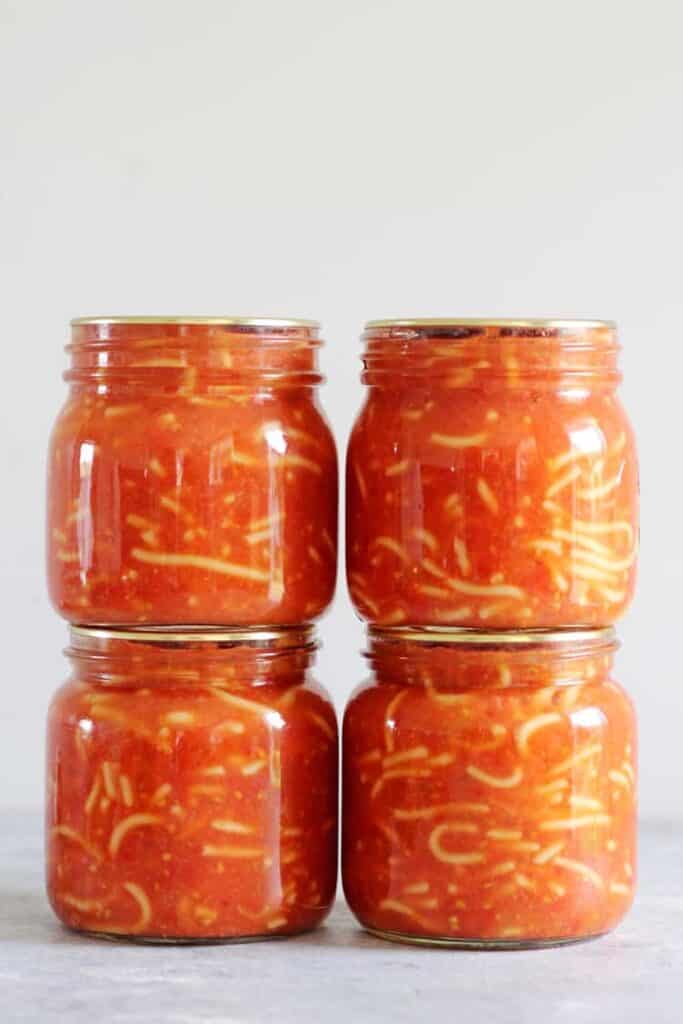
Up until a few years ago, I had NO idea you could make your own bottled spaghetti. We were at Josh's parents house for breakfast and Carol bought a jug of spaghetti to the table. It looked like bought spaghetti but it certainly didn't taste like it - it was SO much better!
The following year I helped Carol make it and since then we have become obsessed with this homemade spaghetti - Sadie too! And because you guys are loving all the preserving recipes I've been sharing, I knew I had to write this one up too.
Before we get started:
We use the overflow method to bottle this spaghetti. If you follow me on Instagram you'll know I've been talking a lot lately about why I am moving away from this method of preserving. The more I read into it, the more I think that using tested recipes and proper methods of heat processing jars of food is the way to go, purely from a food safety point of view.
That being said, my Granny and Mum have both bottled fruit using this method forever with no problems, and I have too. The only reason I'm moving away is because I love trying new things and the science behind how preserving is done using a water bath method makes a lot of sense to me. If you are interested in learning more, I can highly recommend the Blue Book Guide To Preserving (affiliate link) for lots of really useful information.
Anyway, the point is - we have always used the overflow method for this spaghetti. As with anything, if a jar doesn't seal you can't store it at room temperature. It must be refrigerated and eaten immediately or frozen. If you open a jar and it looks, smells or tastes a bit weird, get rid of it. If you are not comfortable with using this method we did try the water bath method with a few jars which I will explain below, so feel free to try that way.
So let's get into how we make spaghetti!
Click here to pin this to your preserving recipes board on Pinterest to save it for later.
You need:
- Jars with sealable lids (we use 500ml Agee Jars)
- Tomatoes, onions, sugar, plain salt and dry spaghetti
- A few basic kitchen things such as chopping board, food processor, knife, a large pot, ladle, a wide mouth jar funnel is helpful and a couple of tea towels.
Step 1: Sterilise your jars and wash lids/seals
I find the easiest way to sterilise your jars or bottles is to run them through the dishwasher on the hottest wash (ours is called hygiene but it may be called sterilise on your machine) This washes and sterilises them and as long as you keep the door shut until you are ready for the jars, it will keep them warm too! If you don't have a dishwasher, wash them thoroughly in hot soapy water and place them in the oven at 150°C for at least 15 minutes or until you need them.
Tip: Always prepare more jars than you think you will need. It is easier to put them back in the cupboard than to try to wash and sterilise one or two extras.
Wash the lids and seals in warm soapy water. We usually place the seals in a bowl and cover them with boiling water until we are ready to use them.
Step 2: Wash and prepare the tomatoes
Firstly, you need to wash the tomatoes. We put the tomatoes in the clean sink, fill it with water and give them a quick wipe down. This is also a good chance to inspect the tomatoes for any blemishes that need to be cut out.
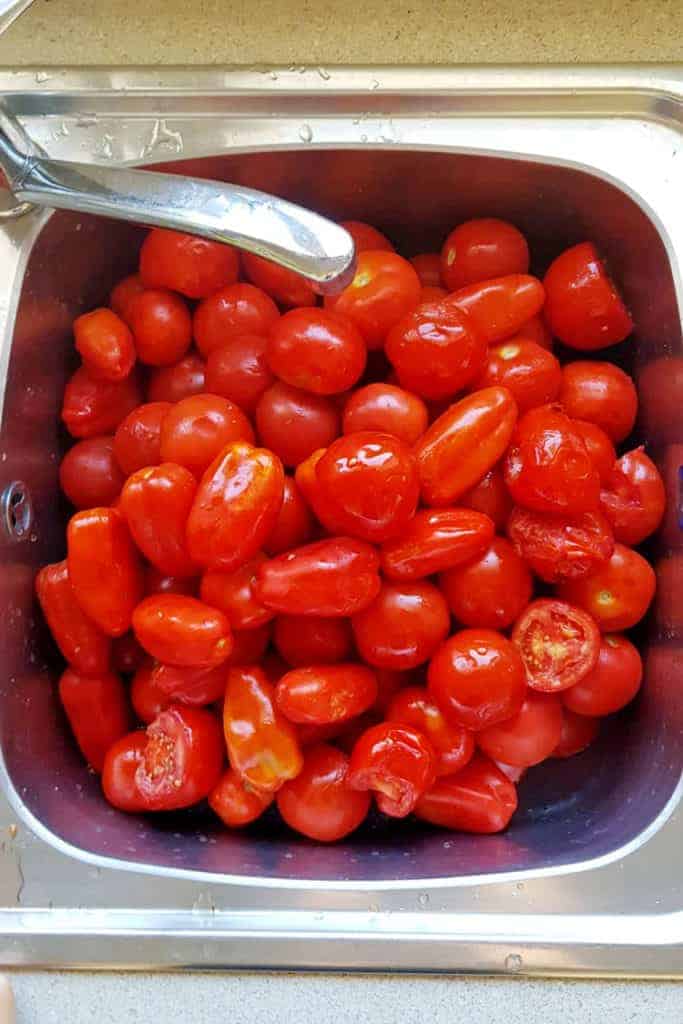
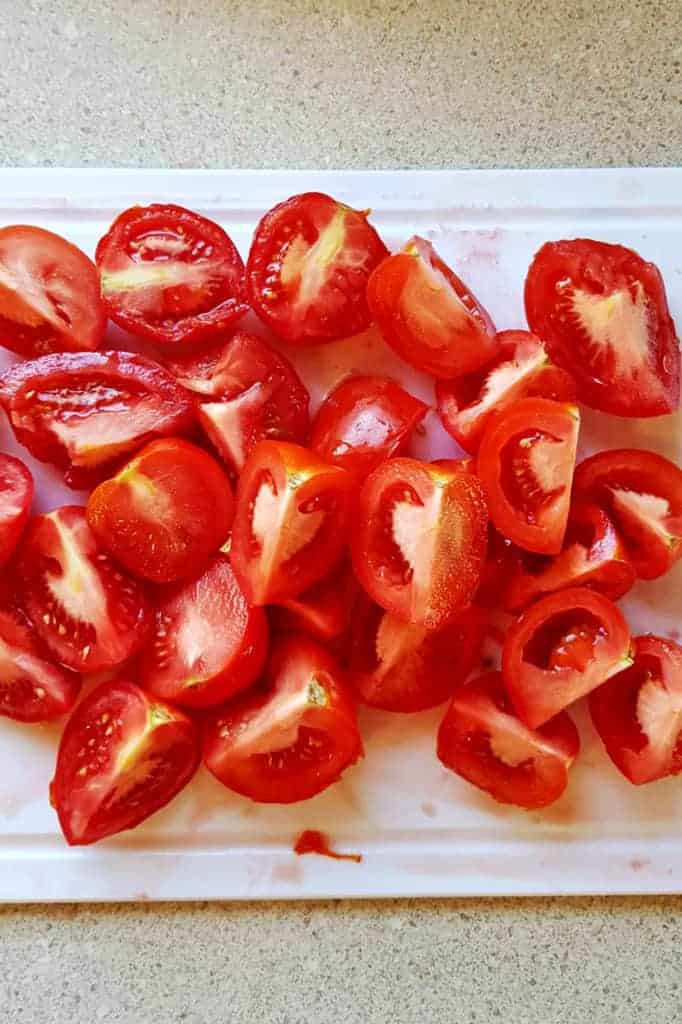
After washing them, chop them into a halves or quarters and place them in a food processor. Blitz them until they are sauce like and pour into a large (the biggest one you have!) stockpot on the stove. While you are blitzing the tomatoes, add the onions to the mix too and blitz them up as well.
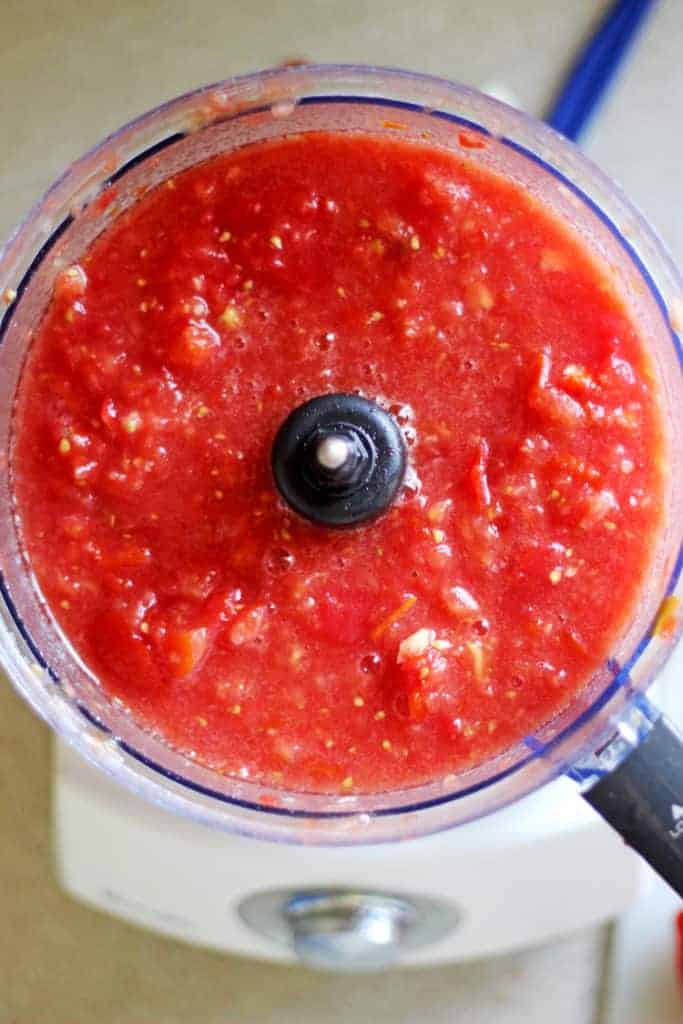
Once all the tomatoes and onions are in the pot, bring it to the boil. This can take a while so we usually have the heat turned on as we are adding tomatoes. This speeds up the process slightly. Once the mixture is at a rolling boil, cook for 15 minutes.
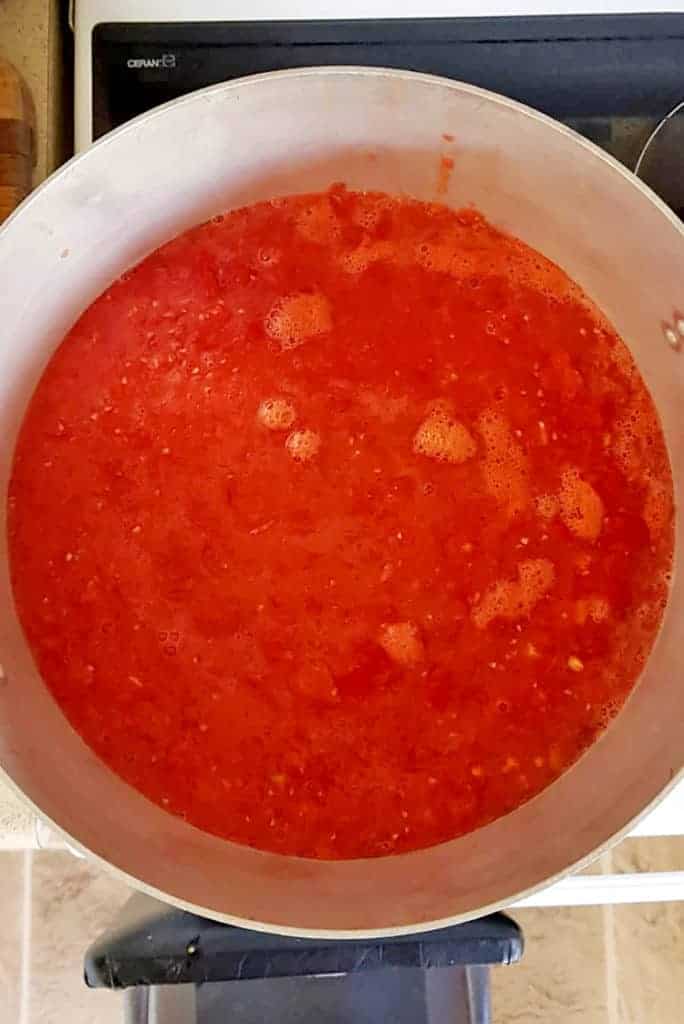
Step 3: Cook the spaghetti
While the tomatoes are cooking, cook one packet of dry spaghetti. Bring a pot of water to the boil (don't add any salt) and cook the spaghetti for 10 minutes.
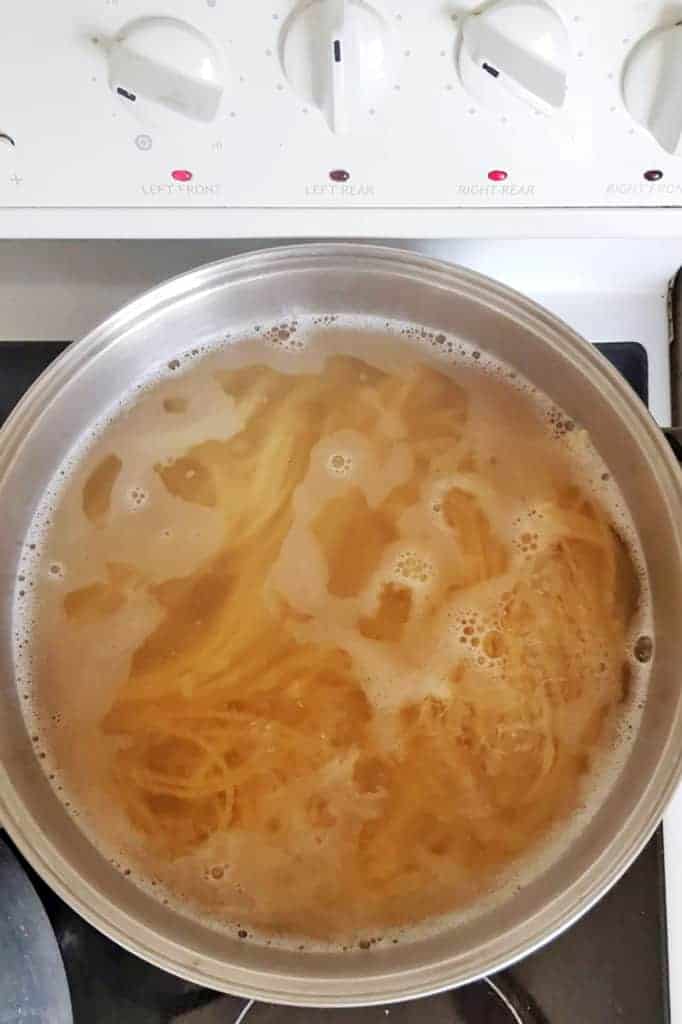
Step 4: Mix it all together
Once the tomatoes and spaghetti are both cooked, drain the spaghetti and add it to the tomato and onion mixture along with the salt and sugar. Mix it together and bring it back to the boil. Once it is boiling, cook for a further 30 minutes. At this stage, you will need to babysit the spaghetti. It can catch on the bottom of the pan pretty easily, so it's worth taking the time to stir it constantly. Once it has finished cooking, take the pot off the heat as you put it into jars.
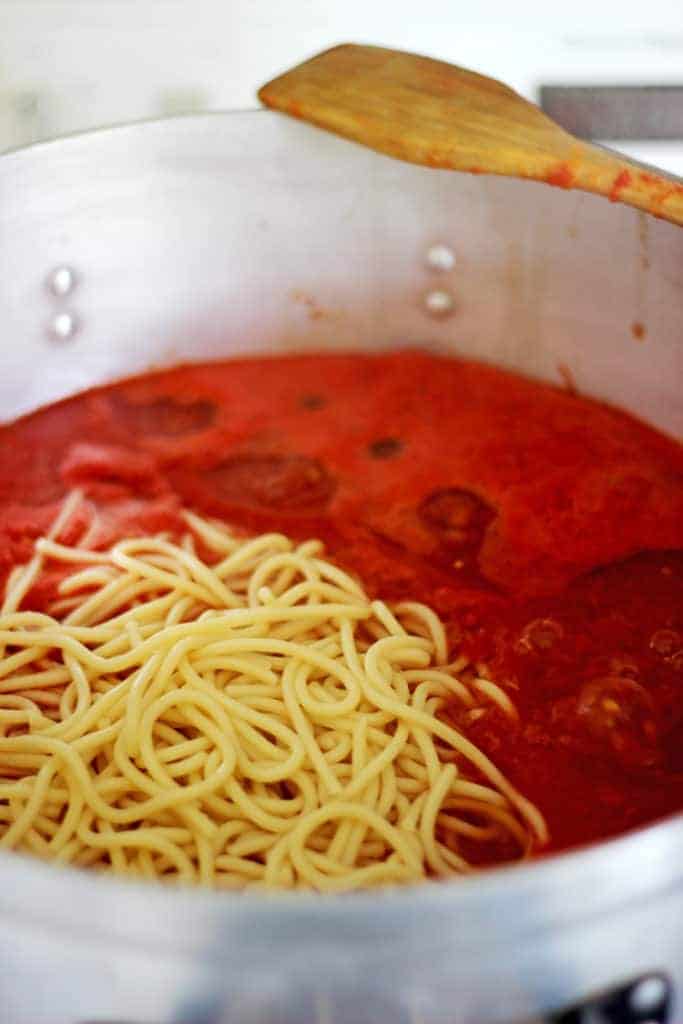
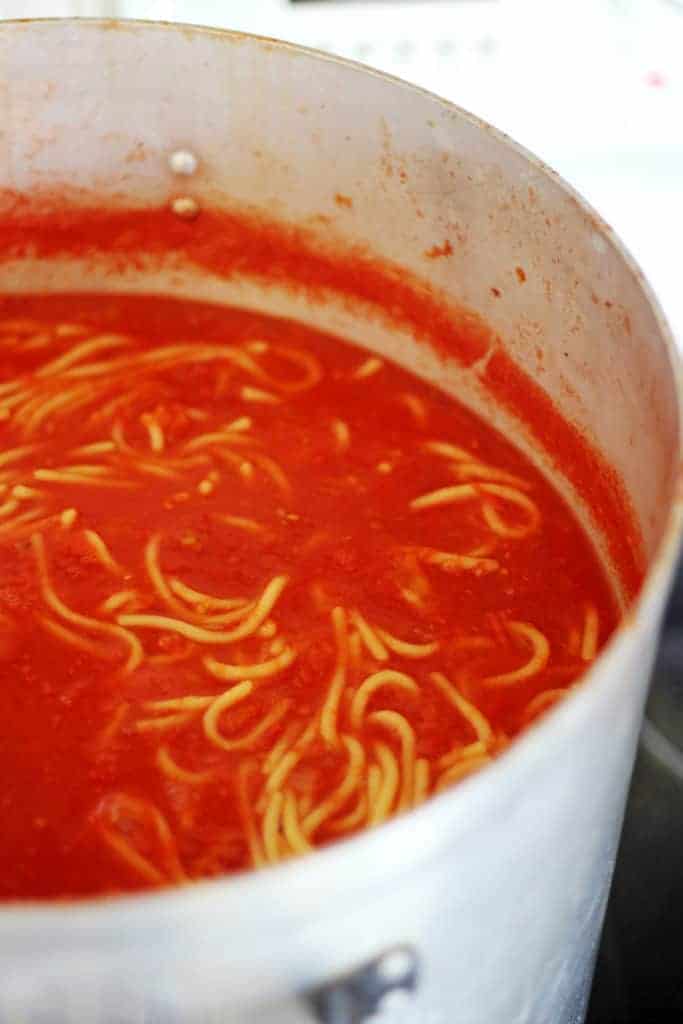
Step 5: Put it into jars
This is where it gets messy! Pouring spaghetti into jars is never going to be the cleanest job but if you have a plastic jug, a ladle and a wide mouth funnel it can be a little easier!
Remember that the jars need to be hot when adding the hot spaghetti, so we like to work 2 at a time, pulling them out of the oven or dishwasher and adding the spaghetti.
Fill a plastic jug with some of the spaghetti mixture. Use the ladle to pour the spaghetti into jars (using the funnel to guide it if you have one). You want to fill them until the spaghetti is as close to the top as you can get it, without it spilling over the rim of the jar. Run a clean spatula or chopstick around the inside of the jar to remove any air bubbles.
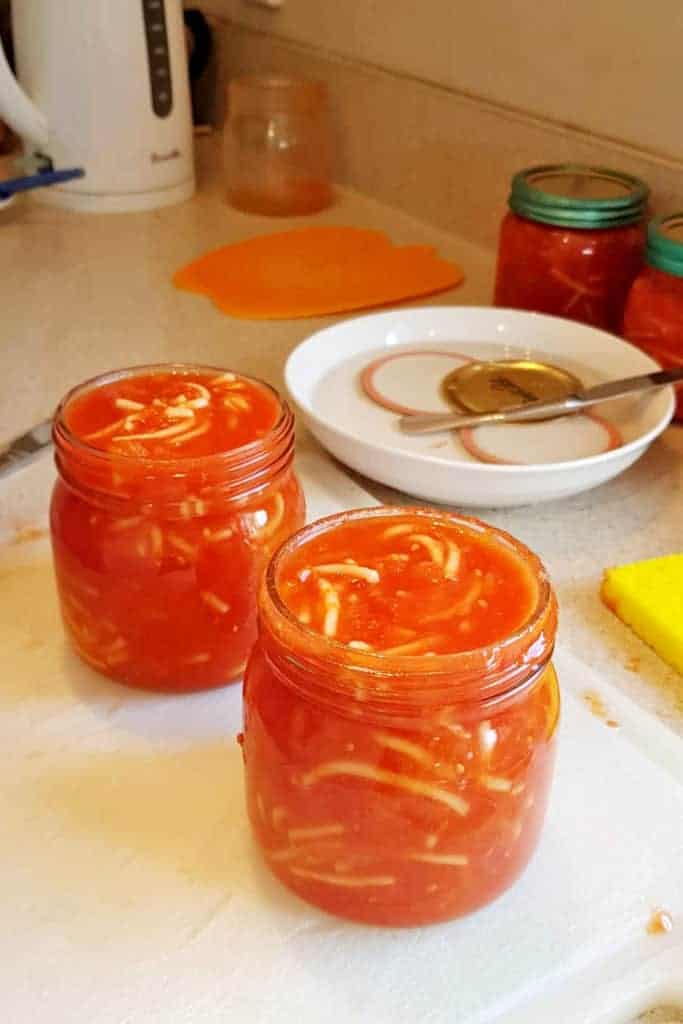
Using a clean damp cloth, wipe around the rim of the jar to remove any juice or seeds and if needed, top up the jar with a splash of boiling water to get the liquid right to the top.
Carefully place a seal on the jar and screw the ring/lid on tightly. Place the jar to the side and move on to the next one. You're done!
How to do this using the water bath method:
If you are more comfortable using the water bath method to process the jars, here is how we did it. Please note, this is not a tested recipe as we are apparently the only people on the internet who make bottled spaghetti!
Fill your biggest stock pot with enough water to submerge the jars and cover them with at least 3cm of water and bring it to the boil. You will need to place a clean tea towel or wire rack on the bottom so that the jars are not in direct contact with the pot.
Before filling the jars we added ¼ teaspoon of citric acid to the jar. This is what I do when bottling diced tomatoes and according to the Blue Book Guide To Preserving, that it what you should do when bottling any kind of tomatoes as it raises the pH level of the tomatoes to bring them into the high acid food zone that makes them safe for storing on the shelf. I realise that following this logic is contradictory to how we bottle them using the overflow method, but as I am learning about the water bath method and safe preserving, this is how I will be starting to do things.
Continue to fill the jars with spaghetti, however you will want to leave a gap at the top of about 1.2cm. Run a clean spatula or chopstick around the inside of the jar to remove any air bubbles. Then place the seal and the lid on.
Place the jars into the boiling water (a set of jar tongs is a super useful tool here) and once all jars are in the pot, bring it back to the boil and process the jars for 90 minutes. Once that time is up, turn off the heat and leave the jars in the water for a further 5 minutes before removing them from the water.
90 minutes might seem like a long time, but the only information that I've been able to find on water bath canning pasta (which can often be frowned upon) is from the Edmond's Cookbook, so I'm happy to use that as a guide.
Step 6: Checking the seals
Once the jars have been processed, leave them sitting on the bench overnight. In the morning, check the seals. Remove the rings from the jars and if they have sealed, the seal will be concave and you won't be able to prise it off using your finger. If the jar has sealed, give the jar a clean with a damp cloth and store in a cool dark place. Properly sealed jars will keep for at least a year.
If the jars haven't sealed they cannot be stored at room temperature but they are still safe to eat. Just place the jar in the fridge and eat within a week. Alternatively, you could transfer the contents of the jar to a freezer proof container and store it in there.
Now you can enjoy homemade spaghetti that is so much tastier than the bought stuff! If there is anything I haven't covered in this post, feel free to comment below and I will do my best to help.
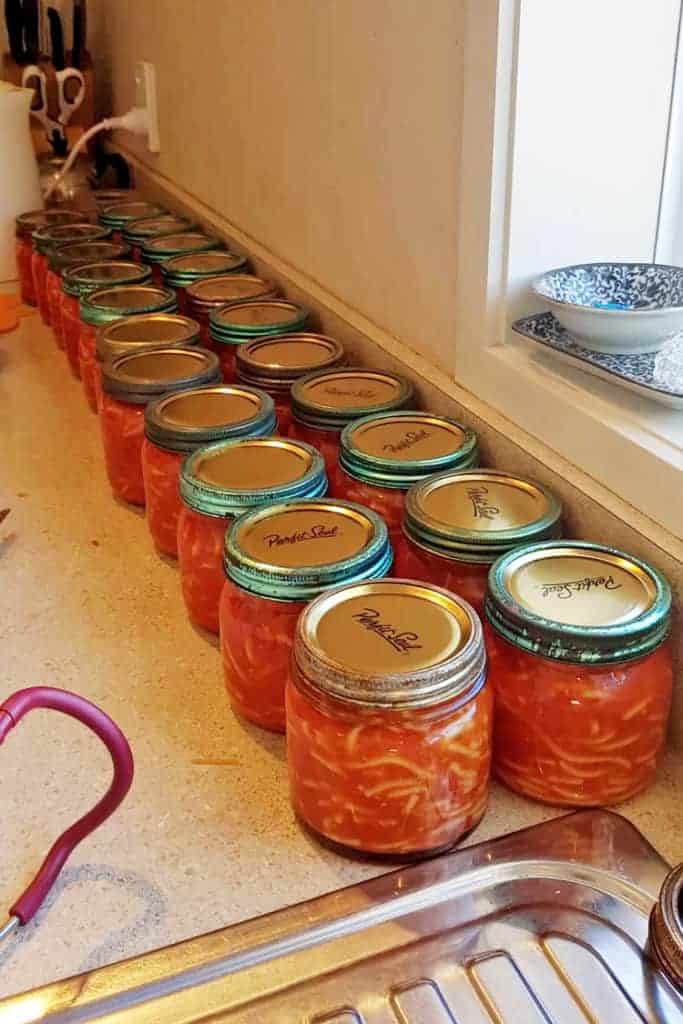
Other preserving recipes you might like:
- How to preserve plums and other stonefruit (oven method)
- How to bottle feijoas (overflow method)
- Homemade Bottled Gherkins (Dill Pickles) (overflow method)
- How to freeze green beans
- How to bottle beetroot (overflow method)
Made this recipe? Tag me on Instagram @thekiwicountrygirl and hashtag it #thekiwicountrygirl.
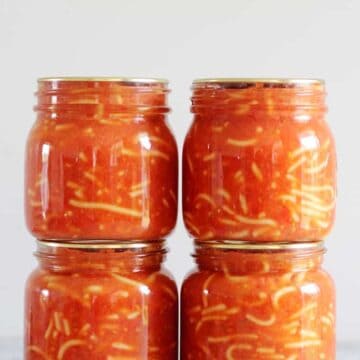
Homemade Bottled Spaghetti
Ingredients
- 5.5 kg tomatoes
- 3 onions
- 500 grams dry spaghetti
- 2 Tablespoons plain salt (not iodised)
- 2 Tablespoons sugar
Instructions
Step 1: Sterilise your jars and wash lids/seals
- 2 hours before you need the jars, run them through the dishwasher on the hottest wash (ours is called hygiene but it may be called sterilise on your machine) Keep the door shut until you are ready for the jars as it will keep them warm until you are ready to use them. If you don’t have a dishwasher, wash the jars thoroughly in hot soapy water and place them in the oven at 150°C for at least 15 minutes or until you need them.Wash the lids and seals in warm soapy water. We usually place the seals in a bowl and cover them with boiling water until we are ready to use them.
Step 2: Wash and prepare the tomatoes and onions
- Put the tomatoes in the clean sink, fill it with water and give them a quick wipe down. Inspect the tomatoes for any blemishes that need to be cut out.After washing them, chop them into a halves or quarters and place them in a food processor. Blitz them until they are sauce like and pour into a large (the biggest one you have!) stockpot on the stove. While you are blitzing the tomatoes, add the onions to the mix too and blitz them up as well.Once all the tomatoes and onions are in the pot, bring it to the boil. This can take a while so we usually have the heat turned on as we are adding tomatoes. This speeds up the process slightly. Once the mixture is at a rolling boil, cook for 15 minutes.
Step 3: Cook the spaghetti
- Bring a pot of water to the boil (don’t add any salt) and cook the spaghetti for 10 minutes. Drain when cooked.
Step 4: Mix it all together
- Add the drained spaghetti to the tomato and onion mixture along with the salt and sugar. Mix it together and bring it back to the boil. Once it is boiling, cook for a further 30 minutes. At this stage, you will need to babysit the spaghetti. It can catch on the bottom of the pan pretty easily, so it’s worth taking the time to stir it constantly. Once it has finished cooking, take the pot off the heat while you are filling the jars.
Step 5: Put it into jars (the overflow method)
- Remember that the jars need to be hot when adding the hot spaghetti, so we like to work 2 at a time, pulling them out of the oven or dishwasher and adding the spaghetti.Fill a plastic jug with some of the spaghetti mixture. Use the ladle to pour the spaghetti into jars (using the funnel to guide it if you have one). You want to fill them until the spaghetti is as close to the top as you can get it, without it spilling over the rim of the jar. Run a clean spatula or chopstick around the inside of the jar to remove any air bubbles.Using a clean damp cloth, wipe around the rim of the jar to remove any juice or seeds and if needed, top up the jar with a splash of boiling water to get the liquid right to the top.Carefully place a seal on the jar and screw the ring/lid on tightly. Place the jar to the side and move on to the next one. You’re done!
Step 5: Put it into jars (the water bath method)
- Fill your biggest stock pot with enough water to submerge the jars and cover them with at least 3cm of water and bring it to the boil. You will need to place a clean tea towel or wire rack on the bottom so that the jars are not in direct contact with the pot.Before filling the jars add ¼ teaspoon of citric acid to the jar. Continue to fill the jars with spaghetti, leaving a 1.2cm a gap at the top. Run a clean spatula or chopstick around the inside of the jar to remove any air bubbles. Place the seal on the jar and screw on the lid/band until just tight.Place the jars into the boiling water (a set of jar tongs is a super useful tool here) and once all jars are in the pot, bring it back to the boil and process the jars for 90 minutes. Once that time is up, turn off the heat and leave the jars in the water for a further 5 minutes before removing them from the water.
Step 6: Checking the seals
- Once the jars have been processed, leave them sitting on the bench overnight. In the morning, check the seals. Remove the rings from the jars and if they have sealed, the seal will be concave and you won’t be able to prise it off using your finger. If the jar has sealed, give the jar a clean with a damp cloth and store in a cool dark place. Properly sealed jars will keep for at least a year.If the jars haven’t sealed they cannot be stored at room temperature but they are still safe to eat. Just place the jar in the fridge and eat within a week. Alternatively, you could transfer the contents of the jar to a freezer proof container and store it in there.



Judy Haylock says
My daughter likes cheesy canned spaghetti.
Would adding cheese to the recipe change anything to do with the cooking process, or the sealing process? Thanks ☺️
Laura says
Hi Judy, I would definitely steer clear of adding cheese to this recipe, it will not keep well in the jar and is likely to mean that the contents of the jars will not keep well.
Mags says
Can you use normal jar or do you have to have the one with the separate lid?
Laura says
I would recommend using the 2 piece system so that you can be sure the jar has sealed
Belinda Mead says
I would like to ask why do you add 1/4 teaspoon of citric acid to the jar?Belinda
Laura says
To bring the acidity of the sauce up to a safe level for bottling. Although spaghetti is a tricky one as there are no real guidelines on bottling pasta either! But this is how our family have done it for years and others too, and it seems to work!
Laura says
Hi Laura,
Can I use frozen tomatoes 🍅?
We froze last year's ones. My kids love spaghetti in a tin and I'm wanting to try your recipe.
Laura says
You sure can!
Andrea McIver says
Dear Laura, thank you so much for posting this recipe. I used to make spaghetti for my children and one of my sons requested that I make it again for his family. I have an old second hand Agee automatic preserver which I have not used yet as I have lost the directions and have not been able to find them on the internet. You gave me confidence to make the spaghetti by the overflow method again. Thank you. Andrea McIver
Deanna Sparks says
I was wondering if it is possible to make this using a pressure cooker? If so, what adjustments might need to be made? Thank you in advance for any advice you may have.
Laura says
Hi Deanna - I have never used a pressure canner so I'm not sure exactly - however it is something that I am keen to try once I bite the bullet and purchase a pressure canner, so when I do I will be sure to update the instructions!
Diana says
Pressure can for 90 minutes
Lee Blanchard says
If the spaghetti is already cooked does it still have to process for 35 minutes? That seems awfully long.
Laura says
Hi Lee, yes, the processing time is not to cook the spaghetti, it is to ensure that the heat penetrates right through the contents of the jar and as spaghetti is very thick, it does need this long time.
Melrose Brightwell says
Have you ever added hamburger to your sauce , if so how long to water bath?
Laura says
You would need to pressure can this if adding meat as the waterbath isn't a safe method for canning meat.
Diana says
Pressure can for 90 minutes.
Ruby says
Hello. Growing up, my mom had canned spaghetti which I never liked but I really want to make some of my own, especially in jars. Have you ever tried your recipe using a few spices, i.e., Italian seasoning, garlic, etc.? Thank you and your MIL for sharing this cool way to store homemade spaghetti.
Laura says
Hi Ruby, no I haven't but you could definitely add dried herbs and spices!
Cherie says
Hi Laura
Is it possible to cook this and freeze in jars as opposed to preserving? Thanks
Laura says
Hi, yes you can - I have frozen jars that haven't sealed before, however the pasta will be quite soft once defrosted so I don't love the end product quite so much!
Cindy Holstien says
Will this same method work for homemade pasta sauce without adding the spaghetti?
Laura says
It sure would!
Pam Davies says
Thank you I had lots of fun making this and it tastes great. I halved the recipe just to try it as its not tomato season yet and they and not all that cheap can't wait till summer when we have home grown or they are really cheap at the green grocer.
Steph says
Hi, just wondering if this will work with gluten free or rice spaghetti? My daughter absolutely loves canned spaghetti, but has started developing an allergic reaction to wheat. She’s also allergic to dairy & soy, so it’s much healthier for her if I can make it myself to avoid cross contamination.
Laura says
Hi Steph - I have never tried this but I can't see any reason that it wouldn't work! I would love to hear how it goes if you try it! Laura
Graeme Barnett says
Hi Laura. I just saw your post. I am gluten free and recently used g.f. noodles and it was fine.
Good luck
Graeme
Julie says
Yes it WORKS!!
I made up a batch of the sauce and separated it into 1/2 normal spaghetti for the kids and half GF for me. I bottled it into smaller jars so it was individual serves 🙂
Jessica says
Hello. I make my own noodles. Will that effect anything? Also, if I wanted to pressure cook and can this do you think 10 psi for 10 minutes would be good? Thank you.
Laura says
Hi Jessica, sorry I won't be much help here. I don't know how it would work with homemade noodles (worth trying though!) and I've never used a pressure canner so I'm not sure how that would work either!
Diana says
Depends on your altitude I'm at 1000 ft above sea level so I use 10 lb on my pressure canner and I do it for 90 minutes that's with me or without me and homemade noodles would be absolutely fine
Helen Potter says
My mum used to make this and I've grown extra tomatoes this year so I can too! I'm wanting to halve the recipe so I'm guessing I just halve everything including the salt and sugar?
Laura says
Yes exactly!!
Judy Haylock says
My daughter likes cheesy canned spaghetti.
Would adding cheese to the recipe change anything to do with the cooking process, or the sealing process? Thanks ☺️
Brenda says
I'm wondering what is the purpose of cooking the cooked sauce and cooked spaghetti for an additional 20 mins, once they have been combined.
Laura says
Hi Brenda, great question - I actually don't know! I'm guessing it's to make sure everything stays really hot throughout before bottling. I'll ask my MIL, it is her MIL's recipe so she may be able to shed some light! Laura
Angie says
I've been trying to find a simple recipe for homemade baked beans, but I think I can tweak this to work. Thank you. We're trying to reduce the amount of 'single-use' waste we create. It's easy to make jams and preserve fruit but trying to find recipes for savoury items has been a bit trickier.
Laura says
Hi Angie, I bet baked beans with this would be delicious! I agree, it's harder to find savoury preserving recipes and often, they are more practical! I am slowly adding my favourites, so keep watching!
Lauren Ratubalavu says
Hi- I was wondering if you knew how to alter the recipe to use canned tomatoes?
Thanks
Laura says
Hi Lauren, no I am not sure sorry, we have only ever done it with fresh tomatoes! I would test it out on a small scale using a can and see how you like it!
Leeanne Meyer says
I have just spent the evening following your receipe for spaghetti. I am so pleased with it, I will never buy another can, I am currently having on toast for dinner
Laura says
Yummy!! I'm so happy you love it!
Laura A says
Fantastic recipe! Love the taste of it!
Got to the end though and realised I forgot to run the butter knife round each jar. Is that going to affect my batch at all?
Laura says
Hi Laura - it will be fine as long as the jars have sealed! Laura
Emma says
Ohhh I need to grow more tomatoes next year so I can try this out. Looks delicious thanks
Laura says
Yes definitely do! Although we actually bought the tomatoes we needed for this - we double the recipe so needed too many at once!
Kirsty McMillan says
How awesome! I remember having home made spaghetti as a kid! Brings back cool memories.
Laura says
I never had it as a kid, but I'll always make it now. So yummy!
Sherwynne says
OMG 😮!!! I just made this!!! Awesome. I had to use tinned tomatoes as I can’t get fresh. I changed the recipe for 4 serves. 4 tins of chopped tomatoes, I drained 2 but next time I might leave the liquid in all. Soooo good!!! No jars, so into the freezer it will go!